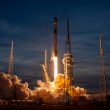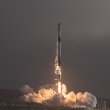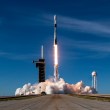Featured image credit: ROSCOSMOS/Yuzhny Space Center
Lift Off Time | July 21, 2021 – 14:58 UTC | 17:58 MSK |
|---|---|
Mission Name | Multipurpose Laboratory Module (MLM) Nauka |
Launch Provider | Khrunichev State Research and Production Space Center |
Customer | ROSCOSMOS |
Rocket | Proton-M |
Launch Location | Launch Complex 200/39, Baikonur Cosmodrome, Kazakhstan |
Payload mass | 23,200 kg (51,147 lb) |
Where did the spacecraft go? | It rendezvoused with the ISS, ~400 km low Earth orbit (LEO) at a 51.6° inclination |
Did they attempt to recover the first stage? | No, this is not a capability of Proton-M |
Where did the first stage land? | The boosters crashed into the steppes of Kazakhstan |
Did they attempt to recover the fairings? | No, this is not a capability of Proton-M |
Were these fairings new? | Yes |
This was the: | – 1st launch of Proton-M in 2021 – 5th uncrewed mission to the ISS of 2021 – 6th launch from the Baikonur Cosmodrome of 2021 – 68th orbital launch attempt of 2021 (66th successful) – 425th launch of the Proton family rockets |
Where to watch | Official replay |
How did it go?
ROSCOSMOS successfully launched the MLM Nauka mission that rendezvoused with the International Space Station (ISS) on July 29. However, shortly after docking, the module started unexpectedly firing, which resulted in the ISS moving 45 degrees out of attitude (more information below). This issue was resolved by the ground control team that stabilized the motion of the ISS.
The Nauka research module – aka the Multipurpose Laboratory Module (MLM) – is a new part of the Russian segment of the ISS. It was launched atop a Proton-M launch vehicle. The rocket lifted off from Launch Complex 200/39, at the Baikonur Cosmodrome in Kazakhstan. This mission marked the first flight of Proton-M in 2021.

MLM Nauka
Nauka (Russian for “science”) is a new research module for the Russian segment of the ISS, developed by the Khrunichev State Research and Production Space Center and RSC Energia (both are a part of Roscosmos located in Moscow). Overall, this module will greatly expand the functionality and a number of workplaces in the Russian part of the ISS.
The development of this module started in late 2004 and was based on the Functional Cargo Block FGB-2, a backup for the currently on-orbit Zarya (Russian for “dawn”) module, which was launched in 1998. It was the first module of the ISS. At that point, Nauka was expected to launch in 2007. However, the project has been repeatedly delayed due to different reasons and circumstances (for instance, because of the flaws found in the module’s propulsion system in 2013).
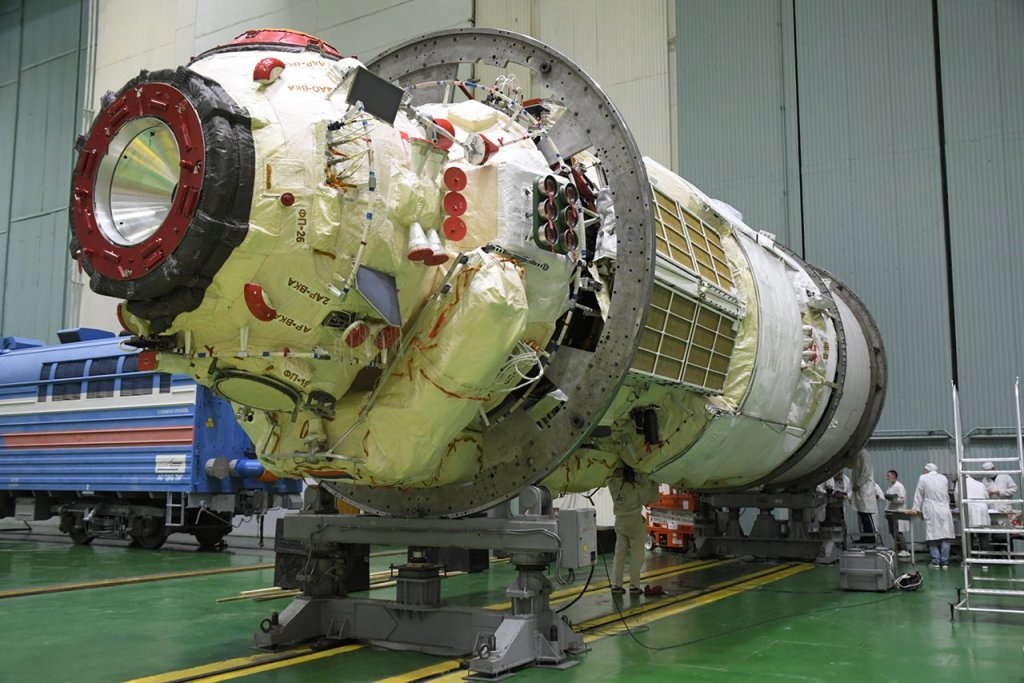
Specifications
Nauka consists of the two main parts: a pressurized cylindrical part and a spherical adapter, they are separated by a bulkhead with a hatch. Some specifications of the module are listed below in the table.
| Mass in orbit | 20,350 kg |
| Length | 13.12 m |
| Diameter | 4.25 m |
| Pressurized volume | 70 m3 |
| Space for scientific equipment, volume | 6 m3 |
| Space for cargo, volume | 4.9 m3 |
| Photoelectric elements, area | 56 m2 |
| Workplaces inside the module | 14 |
| Workplaces outside of the module | 16 |
| Lifespan | 15 years |
Functions
As its name suggests, Nauka is a multipurpose module and will be used for a variety of tasks. Among others, it will feature crew quarters, which will allow to expand the Russian crew to three astronauts. Moreover, it has a new galley, air and water purification systems, and a toilet. The module will be able to generate oxygen for six people and also regenerate water from the urine.
The new module has its own propulsion system, which is capable of autonomously docking to the ISS. Once arrived and docked, its propellant tanks can be used for fuel storage. Nauka also features solar arrays with a span of 23.9 m. This will provide the Russian segment with solar energy, so it can rely less on the ISS’s main set of solar panels.

Moreover, Nauka will be used as a docking port for the Soyuz spacecrafts and Progress capsules before arrival of the new Russian nodal module Prichal (Russian for “pier”). This module is scheduled to launch atop a Soyuz 2.1b rocket on November 24, 2021. Prichal is equipped with six docking ports, one of which will be used to dock to Nauka. The other five will be available for rendezvous with the Soyuz spacecrafts and Progress capsules, as well as with other new modules.
Experiments
However, the primary role of Nauka will be serving as a new and the biggest laboratory module in the Russian segment. Once at the ISS, it will be hosting many exciting experiments.
| Name of the Experiment | Domain of Science |
|---|---|
| Kaplya-2 (Russian for “droplet”) | Space technologies |
| Aseptic | Space biology and physiology |
| Mirage | Space material science |
| Vampire | Space material science |
| Fullerene | Space material science |
| Vitacycle-T | Space biology and physiology |
| BTN-Neutron 2 | Cosmic ray physics |
| Impulse (Stage 2) | Solar system |
| Rakurs (Russian for “angle” or “perspective”) | Space exploration |
| Mutation | Space biology and physiology |
| Perepel (Russian for “quail”) | Space biology and physiology |
All of these unique experiments will bring crucial information and results for different applications. For instance, the Vampire experiment will be performed to grow crystals for advanced infrared sensors that will be used in satellites, while the Perepel one will be trying to develop embryos in quail eggs in microgravity.
European Robotic Arm (ERA)
A new European robotic arm (ERA) flew together with the Russian science module. It was designed and built by European aerospace company Airbus and Space Netherlands for the European Space Agency (ESA).
ERA have some features of human arms: shoulders, elbows, and wrists. It has seven rotational joints, which provide it with a great flexibility of movement. This 11-m long space robot will be used for a variety of tasks. For example, it will move equipment through an airlock to the outside of the ISS. ERA is capable of manoeuvring payloads up to 8,000 kg. Moreover, it will assist spacewalkers by transporting them across the Russian modules.

The ISS already has two robotic arms: Canadarm2 and the Japanese Experiment Module Remote Manipulator System. However, they are not able to cover the Russian segment, they simply do not reach out there. In contrast, ERA will be residing at the Nauka module and will able to move hand-over-hand across the Russian segment. ERA is bilingual robot, its interface supports both Russian and English.
ERA is fully programmable, it can be controlled either from inside or outside of the ISS (a unique feature of this robot) in real time or be pre-programmed. Moreover, the robot will be able to work autonomously. It has four infrared cameras for inspection of the external surfaces of the ISS. Its first task will be to set up the airlock and install a radiator for Nauka. More information on ERA can be found here.
MLM Nauka’s Mission Profile
Launch and Docking
The module separated from the third stage of the Proton-M rocket at ~10 min after the launch. Some insiders claimed that the module experienced a number of technical problems (issues with infrared sensors and thrusters, no confirmation whether an antenna was deployed) after reaching its orbit. However, this information was neither confirmed nor denied by ROSCOSMOS.
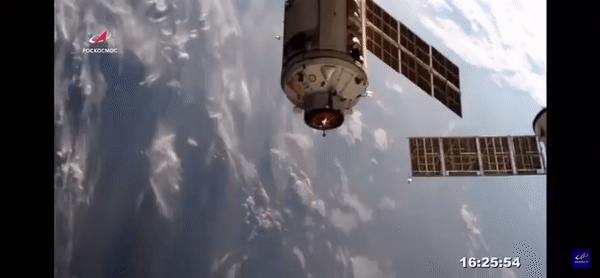
After the separation, several correction maneuvers of the module were conducted on July 22, 24, 27, and 28. The Nauka module autonomously docked to the ISS eight days after the launch, on July 29, at the nadir port of Russia’s Zvezda (Russian for “star”) service module, at 13:29:01 UTC (16:29:01 MSK).
Unexpected Problems
However, following the docking, the module’s thrusters began inadvertently firing when Russian cosmonauts were performing leak checks between Nauka and the service module. This happened because of the occurred issue in the Nauka‘s software. At 16:34 UTC (12:34 EDT), the ISS’s systems registered a first deviation from the nominal attitude. At 16:42 UTC (12:42 EDT), a Loss of Attitude emergency was reported as the ISS moved 45 degrees out of attitude orientation.
Fortunately, flight controllers in Mission Control Houston conducted recovery operations, regained attitude using Progress MS-17’s thrusters, and got the situation under control. At 17:29 UTC (13:29 EDT), attitude control was fully restored. Over this hour, Nauka’s thrusters burned all the remaining fuel. The crew members in the ISS were in no danger and the ISS itself is in good shape.
Next Steps
According to ROSCOSMOS, on July 30, the crew stabilized pressure in the Nauka module. After that, the team proceeded with a hatch opening and taking the air samples. On July 31, the crew performed final air sampling and entered Nauka. Complete integration of the Nauka module in the Russian segment of the ISS will take eight spacewalks.
Because of this incident, Starliner’s OFT-2 mission scheduled to launch on 30 July, has been postponed to NET 3 August 2021, at 17:20 UTC (13:20 EDT).
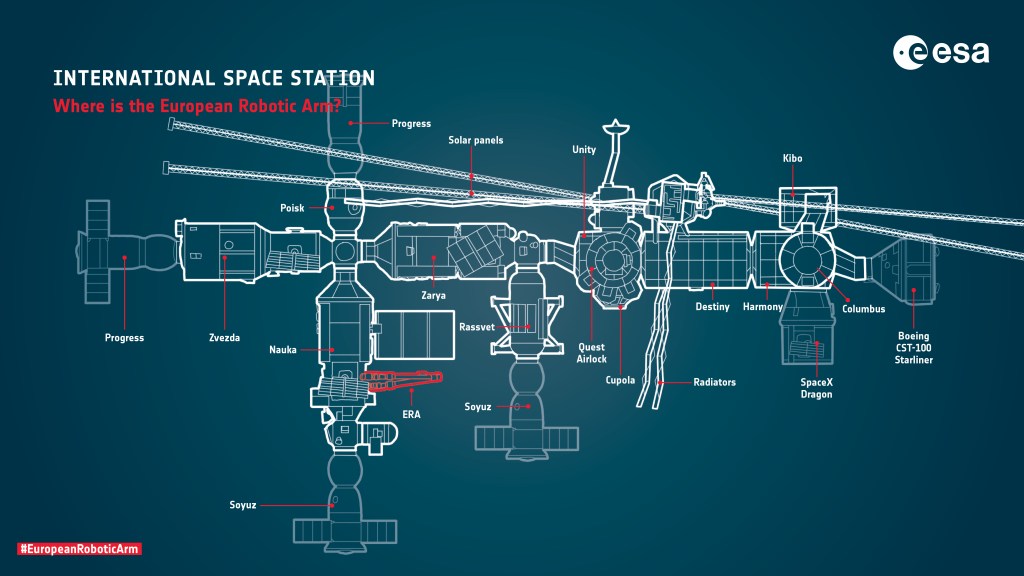
MLM Nauka took place of the Pirs module. Progress MS-16, which launched on February 15, 2021 took care of its removal by undocking along with it from the ISS and deorbiting. The debris splashed into the Pacific Ocean in about 4 hours after undocking. This operation was initially scheduled for July 23 but was postponed and took place on July 26, at 10:56 UTC(13:56 MSK).

The Pirs module was launched from the Baikonur Cosmodrome on September 15, 2001. Therefore, it has served as a docking port for the Progress cargo and crewed Soyuz spacecrafts, as well as an airlock for spacewalks for twenty years.
Timeline
| Hrs:Min:Sec From Lift-Off | Events |
| 00:00:00 | Lift-Off |
| + 00:02:03 | First stage separation |
| + 00:05:31 | Second stage separation |
| + 00:05:46 | Fairing separation |
| + 00:09:40 | MLM Nauka separation |
What is Proton-M?
Proton-M is a multi-use heavy-lift launch vehicle that first flew on April 7, 2001. It is capable to launch civilian and military satellites, as well as cargo missions to the ISS. This launch vehicle was developed and is manufactured by Khrunichev State Research and Production Space Center. Over the decades, several variants of the Proton rocket have been developed and flown over 400 times.
Compared to its ancestor, Proton-K, the Proton-M rocket has a new control system that not only enhances its power performance, but also improves its operational and environmental characteristics. For instance, it makes propellants utilization more efficient. It ensures that almost all fuel on the first stage of Proton-M burns up completely during ascent and the rocket crashes on land with empty tanks, which prevents contamination of the area.
The new system also provides a more controlled landing of the first stage. This has two benefits: easier debris recovery and reduced rent payment (the Baikonur Cosmodrome is located in Kazakhstan, where Russia leases the land). Moreover, it has larger payload fairings, which more than doubles available space for payloads.
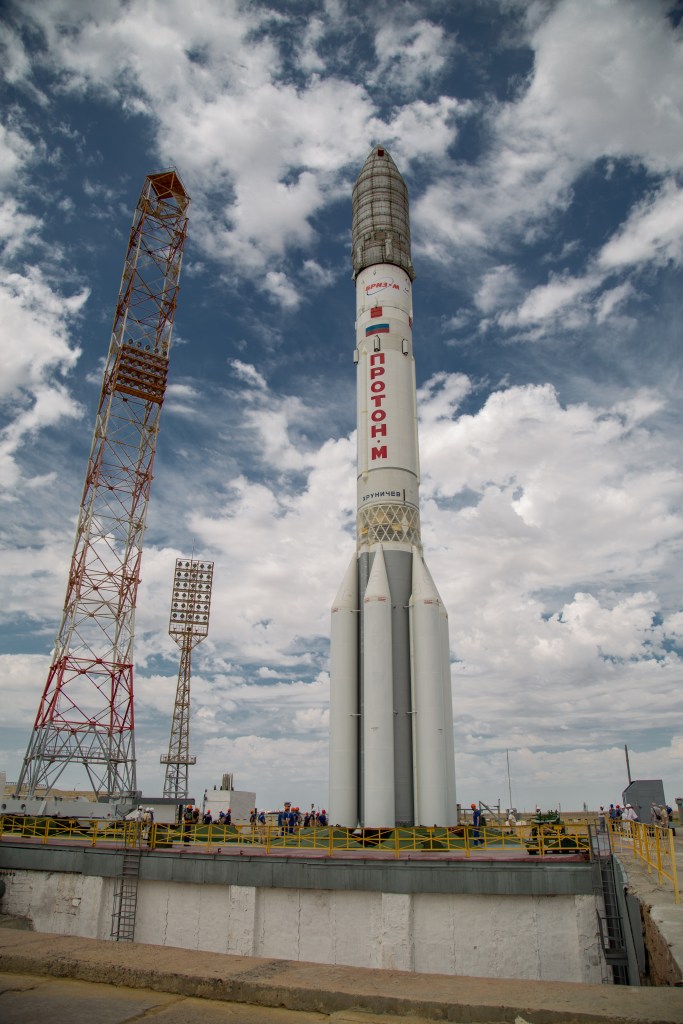
The rocket consists of three stages, all of them are expendable. Proton-M can be accompanied by optional Breeze-M or Block DM-03 fourth stages to insert payloads into a higher orbit.
Proton-M is about 58.2 meters (191 ft) in height and 7.4 meters (24 feet) in diameter. The vehicle’s total lift-off mass is approximately 705,000 kg (1,554,000 lb). The rocket’s payload lift capacity to low-Earth orbit (LEO) is 22,400 kg (49383 Ib).
Stages
| First Stage | Second Stage | Third Stage | |
|---|---|---|---|
| Engine | 6 RD-276 | 3 RD-0210 and 1 RD-0211 | RD-0213 and RD-0214 |
| Total Thrust, kN / Ibf | 10,032 / 2,255,283, sea level | 2,354 kN / 529,200, sea level | 572 / 128,590 Ibf, vacuum |
| Specific Impulse, s | 288, sea level 316, vacuum | 320, sea level 327, vacuum | 325, vacuum |
| Burn time, s | 121 | 211 | 258 |
First Stage
The first stage (21.2 m in length) consists of a central cylindrical part, which is an oxidizer tank, and six side fuel tanks, each one of them is carrying an RD-276 engine. Unlike the four side boosters on Soyuz 2 rockets, the ones on Proton-M are not detachable.
One interesting fact about the Proton-M rocket is that its design was greatly affected by the logistics. For example, the diameter of its oxidizer tank is the maximum that can be delivered to the pad by rail.

The RD-276 engine runs on a hypergolic propellant that uses dinitrogen tetroxide (N2O4) as an oxidizer and unsymmetrical dimethylhydrazine (UDMH, (CH₃)₂N₂H₂) as a fuel. Each one of these engines has one combustion chamber and together they are capable of producing a thrust of 10,032 kN (2,255,283 Ibf) at sea level, with an ISP of 288 s at sea level and 316 s in a vacuum. A burn time of this stage is ∼121 s. The RD-276 engines can control thrust vector by swivelling tangentially up to 7° from their neutral position.
Second Stage
The second stage is 17.1 m long and is powered by three RD-0210 engines and one RD-0211 engine. The engines on this stage start their ignition sequence prior to stage separation. This process is called “hot fire staging”. That is why the second stage is joined to the first one through an interstage with a lattice structure and not through a closed one. This design allows the exhaust to escape and also reduces the mass of the interstage. Each one of these engines has one combustion chamber, runs on UDMH and N2O4, and burns for 211 s. A total thrust produced by this stage is 2,354 kN (529,200 Ibf) with an ISP of 320 s at sea level.
Third Stage
Like the other two stages, the third one operates on UDMH and N2O4. It is 4.1 m long and is powered by one RD-0213 engine, and one RD-0214 engine. The RD-0213 engine has one combustion chamber and burns for 241 s, while RD-0214 has one combustion chamber, four nozzles, and a burn time of 258.3 s. An ISP of this stage is 325 s in a vacuum and a total thrust is 572 kN (128,590 Ibf).

